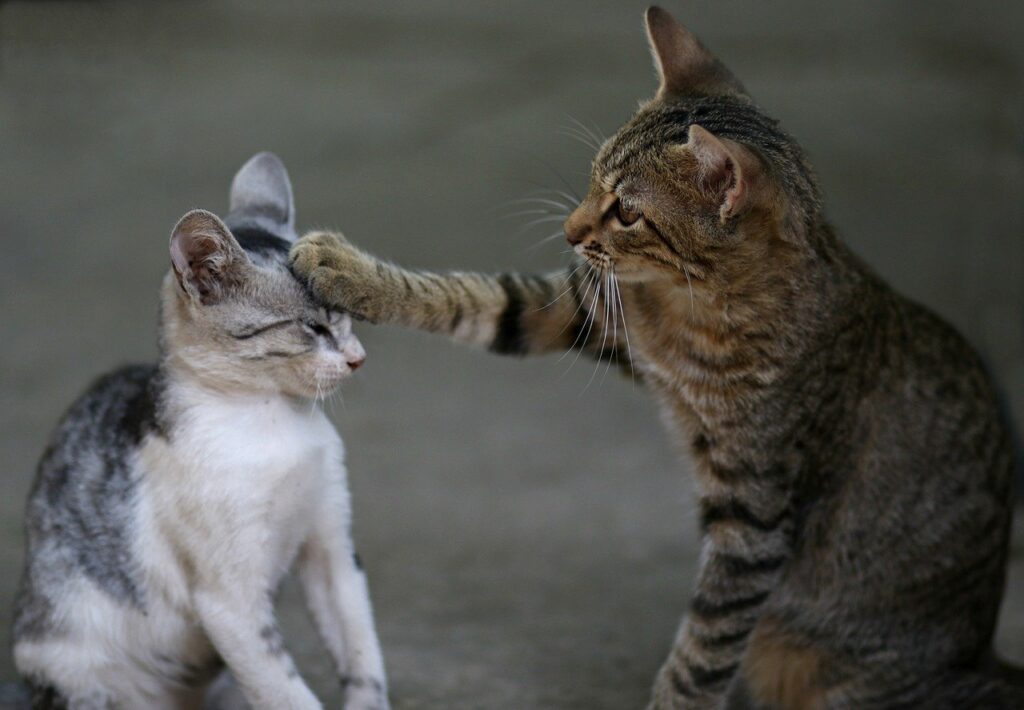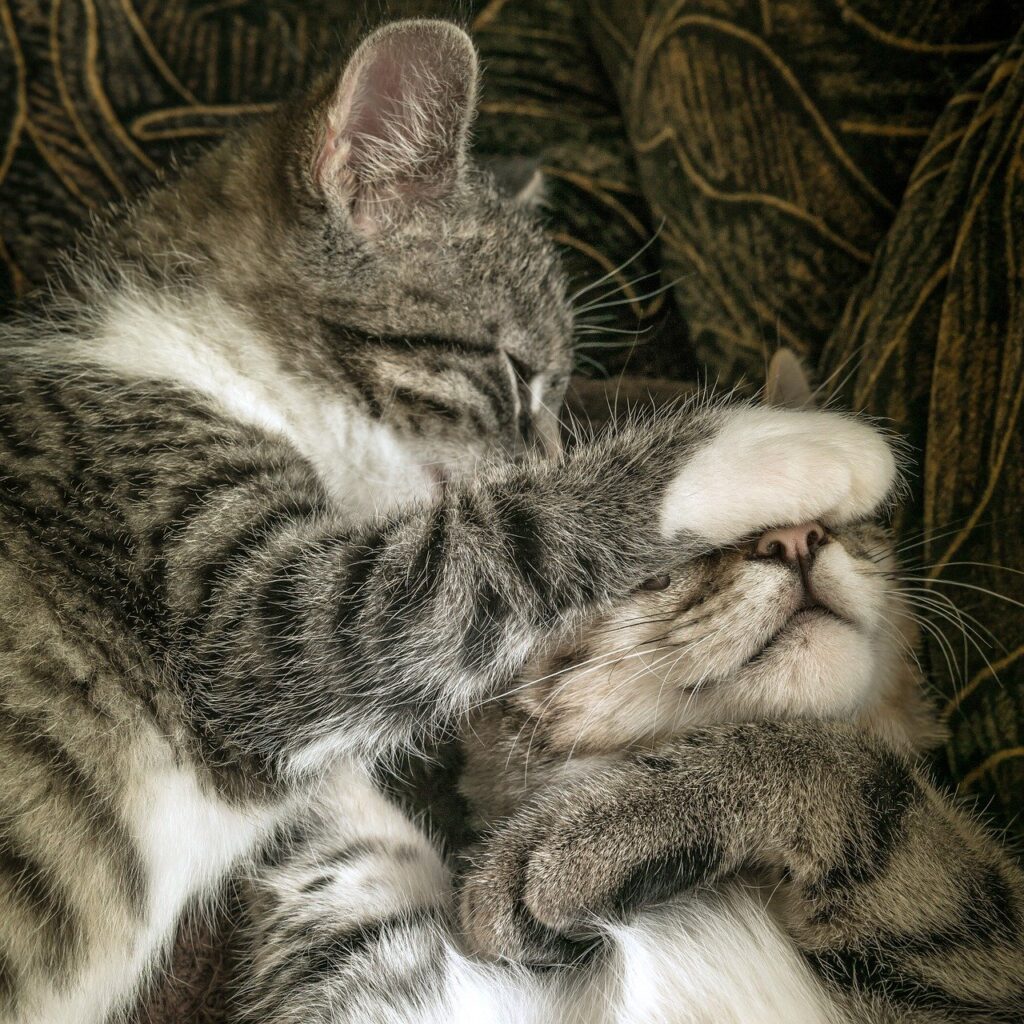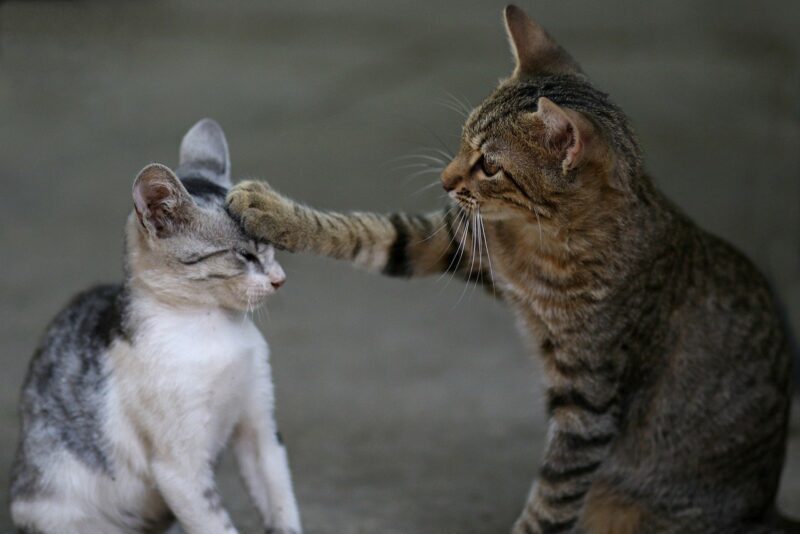Felines are naturally sociable and regularly communicate with their masters, particularly when treats or games are involved. However, how do felines interact with one another? Do they talk to them in a similar way as they talk to you?
Felines, like people, express emotions in a variety of ways. They communicate verbally and also through body language and biological clues. Not every communication could be as clear as a meow. Some types of cat conversations are so complex that you can not guess what they meant. If you were curious about how cats communicate, then this article has got all the details.
How do cats communicate with each other?
1. Meowing, purring, and growling (vocalization)
Felines do communicate with their owners, with a subtle meow to request that their food bowl should be refilled, a high-pitched voice if they want attention, and sometimes a hiss to warn you to get your hands off and leave them alone. Many feline breeds, like the Russian Blue and Siamese are quite chatty and will talk to you a lot, even waking you up at night.
Various meowing levels, severity, and loudness represent the cat’s various psychological and physical needs. If you have several cats in your house, you’re probably aware that they communicate using both verbal and non-verbal feline communication (scent marks, use of tails or paws, curving of the spine, spinning around). Nevertheless, if they communicate with one another using the same way, it needs more expertise and research to prove.
Loud meowing implies stress and panic, whereas lower-intensity meowing signals trust and happiness. Some examples of sounds are:
- Murmuring (purring)
- Sounds of vowels (meowing)
- Growls and howls with a lot of energy
Yes, felines can welcome one another using a meow or vowel tone, but studies have established that felines meow more while socializing with people or sometimes when talking to each other. The study also describes the meowing as a “care-soliciting communication” reserved only for people. However, it isn’t quite that clear.
House cats, on the other hand, are much more talkative than wild cats, who are almost quiet the majority of the time. The only noises you’ll notice among wild felines are growls and the occasional purring.
Purring is created while inhaling and exhaling. Felines purr whenever they communicate with other felines; however, they may also purr while interacting with people and surroundings. They purr while scratching sheets, rolling around on the floor, or rubbing against objects.
Although everybody thinks felines purr whenever they are pleased, they may also purr when sick or anxious. Purring is a complicated speech that requires more research.
When a feline feels afraid, she might snarl or hiss to warn the other feline not to approach or disturb her. If the second feline ignores the warning and tries to come close, the first feline’s voice may intensify to a growl, spit, or screech before initiating a fight. When felines are upset, they can sometimes howl. It’s very logical. The life of a wild cat is significantly more dangerous. They are both predatory animals and victims, and thriving in their habitat requires silence and patience.

2. Body Language
Whenever your felines are engaging with each other, pay attention to their body language. That’s not the only way cats communicate with one another; however, it’s crucial.
Felines have a variety of ways and means of expressing their affection for one another, such as brushing noses or snuggling against one another. They also like to lick the other feline’s head to express love.
You’ve probably noticed your feline licking the head of some other feline’s head like a friendly hello as she walks to another room or up the stairwell.
A similar method can also be used to cheer up an angry kitty.
This experience remains in their fuzzy cat minds, and they utilize it to show affection and sympathy as adults. Feline pals also rest alongside, groom one another, and exercise together.
When two kitties meet, they usually engage in a number of rituals:
- The more experienced feline is likely to hiss at the stranger.
- The new feline will occasionally hiss back at the old one.
It’s simply a threat from the domestic feline. Based on the characteristics of the felines engaged, it might not even result in anything. If the new feline doesn’t step back as fast as possible, the hissing could be followed by a growling. But, if there’s a lot of wailing and shouting, there’s typically nothing to be concerned about.

When a feline or kitty rolls over, a portion of their stomach is exposed to another feline. It indicates that she is secure enough to reveal the most vital organs of her body to another feline. If your feline feels unsure or nervous, she might stoop down, curl her tail under her belly, and watch the unknown feline for a moment.
This habit is usually observed in kitties and young felines, who like to ‘play-fight’ with their siblings or companions in this manner. But they also have other indications. It might indicate mutual understanding and a desire to be open up between two felines. It might also mean something quite the opposite. Stray felines, in nature, defend themselves by exposing their bellies.
Predators are scared by the felines by flipping onto their backsides. If a feline engages in a battle, it will flip around to reach most of its defensive weapons (teeth and claws) to protect itself. A startled feline can attack and defend its important organs hidden in the abdomen by lying down.
Your feline’s eyes are wide open and enlarged, their ears are flat, and their tails are straight up in the air, indicating that something is wrong between them and that a quarrel is likely to start.
But on the other hand, ears are erect, and eyelids are shut or dilated, indicating that the felines have resolved their concerns and are very comfortable with each other. Cats are incredibly aware of their environment and are always watching themselves. If your feline shuts its eyes and rests when another feline is around them, it suggests they completely trust them and are not expecting any threat to keep its eyes half-opened.
Your cat’s tail has a lot to say about them:
- When getting near another feline, your pet’s tail is upright and extended high in the air, suggesting kind and friendly behavior.
- Your feline is displaying aggressiveness when its tail is extended out and swings quickly from one side to another.
- If your pet’s tail is pumped outside and held high, she is attempting to make herself look taller and more powerful in the presence of another feline’s aggressiveness, or there could be another risk.
- If your feline tries to fit her tail under her hind legs, she is most likely expressing nervousness or surrender.
Ears and eyes:
- When your feline’s eyes are fully open and enlarged, the ears are flattened, and a battle will start with some other feline.
- When your feline’s ears are erect, her eyelids are a little open or shut, then the felines feel comfortable with others.
- When your feline completely shuts her eyes around another feline, she trusts that she is not being attacked and can rest her eyes.
Read also: Hypoallergenic cat breeds
3. Scent
Okay, so smell is important in feline communication. Felines brush their cheeks (which contain pheromone-releasing glands) around each other in a similar way they brush their faces on their owners. Felines could be very sociable. They express their love by brushing their cheeks together and on their bodies.
They release pheromones and chemicals from the smell receptors on their foreheads, cheekbones, and jawline as they are doing this. They also transfer smells whenever their bellies and tails touch against one another. Felines would also leave a chemical trace and claim their territory by rubbing on noticeable things in the environment.
They may also claim their area by spraying urine. It is normal behavior among felines living outdoors or frequently going for a stroll outside. Spraying, on the other hand, might happen within the household.
Whenever it happens, it might be due to the presence of an outdoor feline on the premises or another high level of stress in your pet’s life. Scent marks are the major means by which felines interact with one another. A feline brushing her head on another feline’s face is common. This move conveys that the two feel relaxed in one other’s presence.
It’s a unique method of expressing love. Even if the felines aren’t highly attached, smell has significance. That’s right; I’m talking about butt-smelling and spraying. Although felines don’t appear to sniff people’s butts as canines do, they like to do it as a sort of greeting gesture.
They begin sniffing each other’s butts after touching each other’s cheeks and necks. However, they will always do that only if they feel safe around each other and have established trust. It’s a warm and respectful greeting between two felines that are familiar with one another.
And what about spraying? That is solely a territorial matter. It may be argued that leaving their waste in the cat litter box unattended is a form of territorial thing. Even so, the feline who fails to remove its waste is signaling to the other felines that she is the alpha cat and no one should mess with her.
Felines are highly attentive and observe other felines waste to check whatever information they can collect about her. It’s more than just territorial things and sexual messages; identifying a feline’s scent and its meaning is a lot to study for humans.
Cats’ communication research
Professor Alphonse Leon Grimaldi published an article describing what felines were communicating with people in 1895 when felines were only starting to become widespread home pets. They were primarily wild animals until 1895. They were employed to trap rats but have not usually been brought indoors or cherished as pets. Grimaldi converted a few frequent cat terms into the human language in his article “The Cat.” He thought “Aelio” represented “meal,” for instance.
Some feline specialists still think that people may understand specific feline sounds over a century. Writer and environmentalist Jean Craighead George grouped cat vocal sounds in a manner that can appear related to human communication. She believes that “Mee-o-ow” (in a rising pitch) is a scream or a moan, for instance (Robins 2014).
However, not every expert agrees that feline noises could be easily understood. In a 2003 research titled “Identification of domestic cat (Felis catus) vocalizations,” Nicholas Nicastro and Michael Owren discovered that felines do not use vocal sounds to draw people’s attention; however, willingness to explain those sounds is highly dependent on the individual. Pet parents are far better at understanding what their pets are saying (Nicastro and Owren 2003).
One prevalent misconception among pet parents is that felines only purr if they are pleased. Although most kitties purr whenever they are pleased, they sometimes purr whenever they are nervous or in discomfort, according to Sandy Robins (Robins 2014).
Felines use their tails to interact with people and other felines, and it is among the most common ways they can engage with everyone. A comfortable and pleasant cat walks with its tail erect. A feline’s tail twirling back and forward rapidly might indicate anger or curiosity. When a feline’s tail is puffy, and the fur rises on top, it signifies the feline is frightened and attempting to make it appear larger to scare off the attacker (Newman, Alexander, and Weiztman 2015).
Final Thought
Trying to figure out what felines are talking to one another is just like watching a foreign-language movie without subtitles. You waste so much time attempting to understand whatever they’re trying to say.
Cat speech is complex, and specialists have yet to figure out the complete feline vocabulary. Even so, you can look closer at your feline’s behaviors with other felines and use the information provided in this article to “understand” what your kitty is talking about.
Body language accounts for a large percentage of cat-to-cat communication, and those who have spent time studying felines have developed a good understanding of it.
